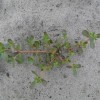Abstract
Purslane occurs throughout the year in Florida. It produces thousands of seeds per plant, which germinate readily, but can also persist in the soil for up to 15 years. Vegetative shoot fragments can survive on the soil surface for extended periods of time, then re-root when exposed to moisture and can even flower and produce seeds after they have been pulled from the soil. This characteristic enables purslane to persist and spread following cultivation. This 4-page fact sheet was written by Nathan S. Boyd, Andrew W. MacRae, Rick Kelly, and Ixchel M. Hernandez, and published by the UF Department of Horticultural Sciences, July 2014.
References
Bryson, C. T., and M. S. DeFelice, eds. 2009. Weeds of the South. Athens: University of Georgia Press.
Miyanishi, K., and P. B. Cavers. 1980. The biology of Canadian weeds, 40. Portulaca oleracea L. Can J. Plant Sci. 60:953-963 https://doi.org/10.4141/cjps80-139

